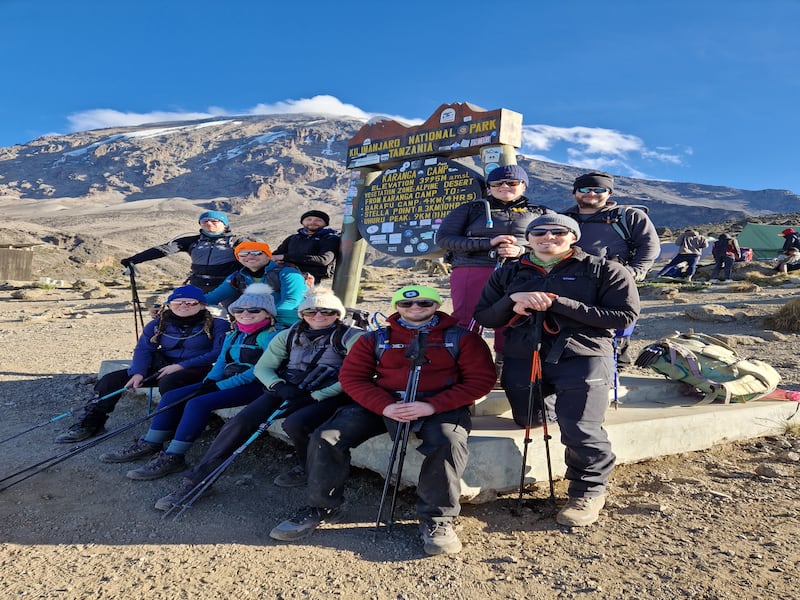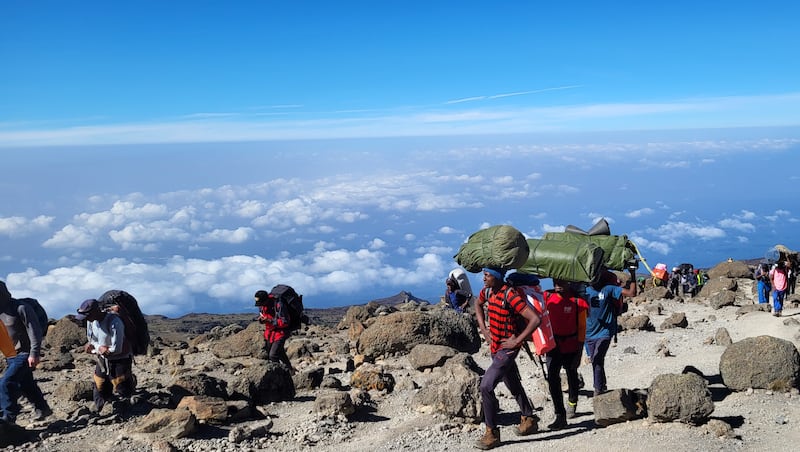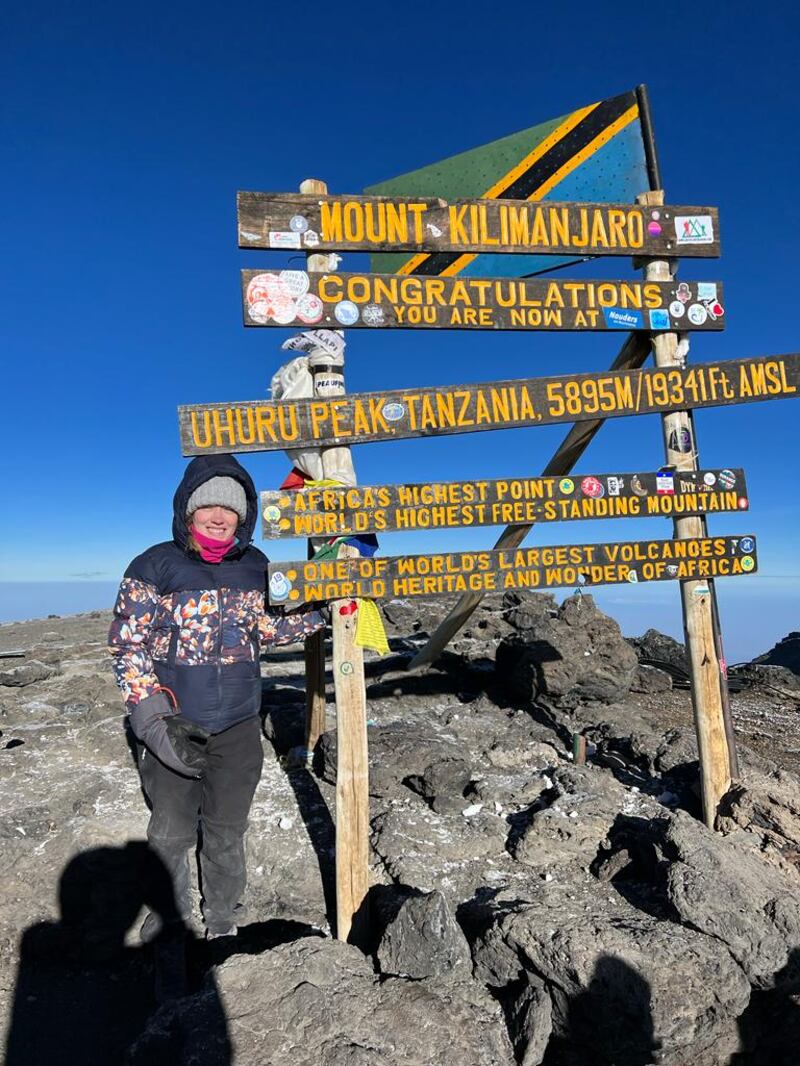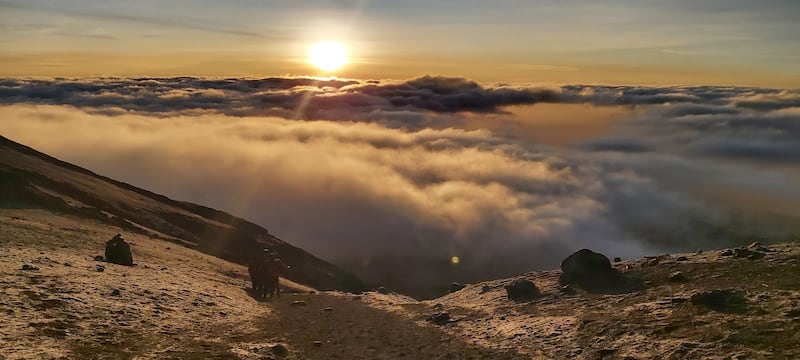“Drinking Kilimanjaro whiskey is very important,” says Goodluck, our co-head guide, who is preparing us for our seven-day trek on the world’s tallest free-standing mountain.
Sitting in a circle around him as he briefs us on our expedition, several eyebrows rise in excitement at his words. Whiskey? On the mountain? Sounds fantastic.
Goodluck quickly crushes those thoughts when he adds: “We have a special name for water. It’s Kilimanjaro whiskey.”
Ah, I guess that makes more sense. Eleven of us are about to begin an attempt to summit Mount Kilimanjaro in Tanzania, which stands at 5,895m (19,341ft) above sea level.
A dormant stratovolcano, composed of three different volcanic cones, Kilimanjaro has five different climate zones: bushland, rainforest, heather and moorland zone, alpine desert and the arctic zone.
We begin our trek in the rainforest zone at the Machame gate, at 1,800m (5,906ft). We are clean and odour-free. This will be the last time we will look or smell as fragrant for a week.
Trekking through a rainforest means you’re surrounded by natural beauty, and bear witness to remarkable animals including the black and white colobus monkey and a blue monkey.

The temperature reaches 33 degrees on the day we did it, but thankfully the shade created by the tall trees overhead protects us from the intensity of the sun.
Upon our arrival at Machame camp, at 2,980m (9,777ft), we eat our dinner before going to bed. We wake up just before 6am every morning, with a softly spoken “good morning” from one of our porters, Emmanuel, who brings us a cup of tea or coffee to our tent.
“Sleep well? Like a baby?” he asks daily. We don’t have the heart to tell him that we slept like a baby who wakes up every few hours.
Day two is a more exciting endeavour. It requires climbing over rocks uphill, before a nice, steady traverse to the left.
[ ‘What the feck are you at?’ I’ve asked myself at times over the last 14,000kmOpens in new window ]
We quickly realise it isn’t just whiskey that changes when the word Kilimanjaro is put in front of it; there is also the phenomenon we have termed Kilimanjaro time.
“It’s only half an hour more,” we are told, before we walk for another hour straight.
“Just around the corner” is another bald-faced lie. There are at least five corners between our location and the one at which the camp is just around.
Things begin to feel more strenuous on day three. We trek up to Lava Tower at 4,572m (15,000ft) high for lunch in a bid to help acclimatise to the altitude, before descending to Barranco camp at 3,950m (12,959ft).
The food is great throughout the trip. Breakfast features porridge, omelette, pancakes, toast, fresh fruit and sausages. Lunch and dinners consist mostly of hearty meat and veg dishes with rice, pasta or potatoes.

One day we receive a very special surprise of pizza and chips, the sight of which almost moves this reporter to tears. I’m blaming the altitude.
In terms of technicality, Kilimanjaro is an easy climb. There is only one day on the Machame route that requires some level of technique, which is on day four when climbers take on the Barranco wall.
It looks intimidating from camp, but much of the group agree that it is the most enjoyable day of the trek. For those of us on the shorter side, however, it poses additional challenges.
“Big stretch,” my fellow trekkers call out to me like I’m a pet. At one point, it feels like I’m close to doing the splits when trying to step from one rock to the next.
The biggest challenge posed by Kilimanjaro is the altitude, and those travelling from countries close to sea level, like Ireland, are at a distinct disadvantage.
Booking the expedition through Irish company Earth’s Edge means an international doctor accompanies us on the trip.
Our doctor Stefan Hudson, who we affectionately call Dr JB due to his near-constant supply of jelly baby sweets, is able to monitor symptoms of altitude sickness as we progress up the mountain.

While I am fortunate to escape any symptoms, others experience headaches, nausea, dizziness and confusion.
We move pole, pole – meaning slowly, slowly in Swahili – in a bid to mitigate the effects of the altitude on our bodies. On the way back down, however, it feels more like we were doing roly poly, than pole, pole.
The hardest part, by far, is summit night, which begins in the early hours of day six. We wake up at midnight, pack up our bags, and force ourselves to eat a bowl of porridge and drink some tea before beginning the final ascent at 1am.
It is pitch black, with only our headtorches providing limited illumination as we navigate our way up to the final 1,095m (3,593ft) in minus six degrees weather, with wind chill making it feel considerably colder than the number on the thermometer.
Most companies begin their summit push from Barafu camp, but we have a distinct advantage of camping at Kosovo camp, which requires a special permit, and shaves at least an hour off our summit attempt.
We were advised by previous summiteers to have a song in your head that you repeat to get you through what feels like a never-ending trek. Instead, most of us opt for an internal refrain of “what the hell am I doing? Why did I sign up for this? Will it ever end?”
[ A skiing holiday with small children? It can be relaxing, high octane funOpens in new window ]
But as the day begins to break through the clouds as we near Stella Point, a short distance away from Uhuru Peak, the brightness of the sun is rivalled only by the smiles of relief on our faces.
Watching the sunrise from the roof of Africa is the most amazing experience, made even better by the smattering of snow and glaciers that surrounded us.

Though, that won’t be a universal experience for much longer. Unfortunately, the glaciers are shrinking year on year, with a recent UN report saying they will be unavoidably lost by 2050 due to climate change.
We spend a grand total of 10 minutes at the summit, where we take our photos, before quickly beginning our descent. It is a sandy path downwards as we make our way back towards camp for a short nap and some lunch, before descending even further again.
After a total of 14 hours of trekking that day, we sleep at Millenium camp, before the final six-hour trek the following day to Mweka Gate.
The expedition and sense of accomplishment is the driving force behind many people’s decision to summit Kilimanjaro, but by and large the best part of the trip is the people you meet along the way.
I purposely booked the trip as a solo adventure to push myself outside of my comfort zone, and that was possibly the best idea I have ever had. I’ve made friends for life, with people of all ages and from all places.
[ Return of the travel agents: The package holiday is making a comebackOpens in new window ]
Our international guide Louise Lawrence who accompanied us from Dublin was a beacon of support and joy, while the local porters, guides and cooks provided motivation when it felt like ours had depleted.
They sang call-and-response chants, ensured we ate delicious meals, pitched and unpitched our tents every day, and, for some people who shall remain nameless, even helped them pack their bags.
In the words of the porters themselves, we truly became “one team, one family. One family, one team”.




















